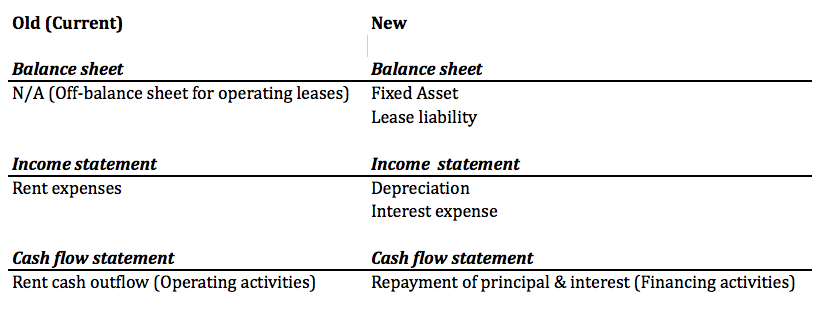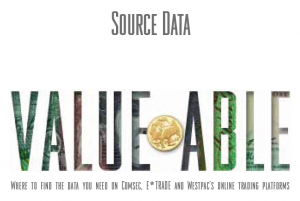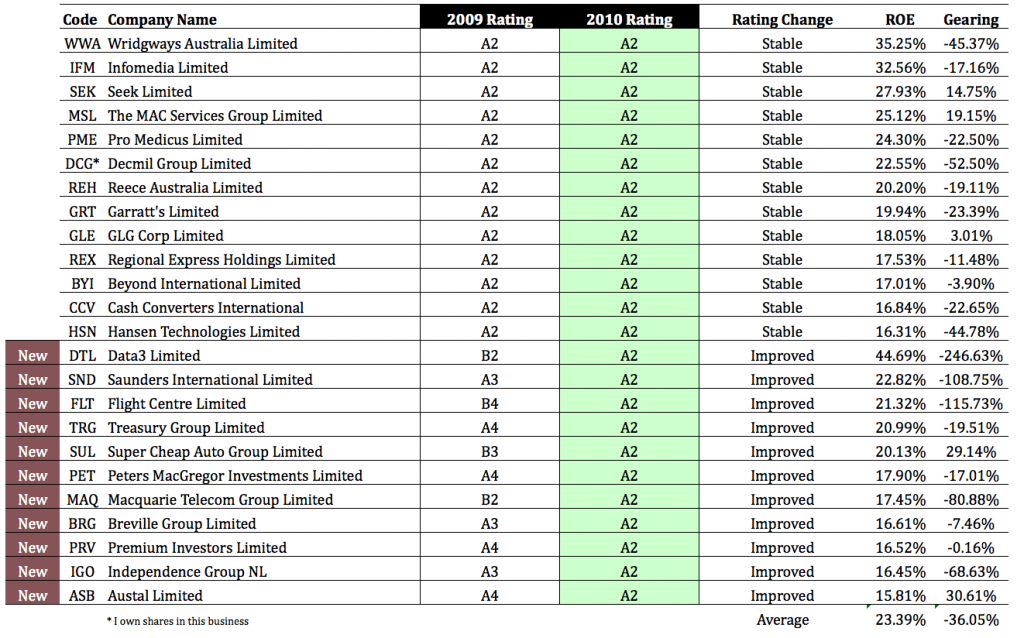Investing Education
-
Have you been getting your daily dose?
Roger Montgomery
November 9, 2010
 If only it worked that well all the time!
If only it worked that well all the time!Last Thursday evening (4 November) on Peter’s Switzer TV I listed, amongst other companies, Credit Corp and Forge Group as two I would have in the hypothetical Self Managed Super Fund Peter challenged me to set up that day.
Why did I nominate CCP and FGE? Both receive my A1 or A2 MQR and both have been trading at a discount to their intrinsic value.
If you are a regular reader of my blog you would have read my insights for some months on these companies. And if you saw today’s announcements, you can imagine why I am a little happier than usual.
Credit Corp’s previous 2011 NPAT guidance was $16-$18 million. Today the company announced FY11 would likely produce an NPAT result of $18-$20 million.
Forge Group’s announcement states “The Board wishes to advise that the company forecasts net profit before tax for the half year ending 31st December 2010 to be in the range of $25-$27 million. This represents an improvement on the previous corresponding period (pcp $19.04m) of up to 42%.”
As I fly to Perth for a presentation and company visit, I am encouraged that several of the companies Value.able graduates mentioned in our lists are also hitting new 52-week highs. In a rising market that lifts all boats, it is perhaps unsurprising, but nevertheless it should be an encouragement to Value.able graduates and value investors that companies like FLT, DCG, MIN, FWD, FGE, CCP, NCK, DTL, MCE, MTU and TGA have all hit year highs – some of them yesterday. More importantly those prices are perhaps justified by their intrinsic values.
Of course I am not here to predict where those prices will go next, because I simply don’t know. Short-term prices are largely a function of popularity and the market could begin a QE2-inspired correction, an Indian infrastructure-inspired bubble or a China liquidity-inspired bubble tomorrow. I have no way of telling and instead, I focus on intrinsic values and only pay cursory attention to share prices.
So, as I always say, seek and take personal professional advice before taking any action and remember that 1) I don’t know where the share price is going 2) I am under no obligation to keep you up-to-date with my thoughts about these or any company, my Montgomery Quality Ratings or my valuations and I might change my views, values and MQRs at any time so don’t rely on them and 3) I may buy or sell shares in any company mentioned here at any time without informing you.
And so I remind you one more time. Please seek and take personal professional advice and always conduct your own research.
Posted by Roger Montgomery, 9 November 2011.
by Roger Montgomery Posted in Companies, Insightful Insights, Investing Education, Value.able.
-
Are you drowning in a sea of complexity?
Roger Montgomery
November 3, 2010
 I don’t know if you have noticed but some of my recent posts and comments have been getting a little technical. I am sorry about that, I get a bit carried away sometimes.
I don’t know if you have noticed but some of my recent posts and comments have been getting a little technical. I am sorry about that, I get a bit carried away sometimes.Of course on this blog, I am not alone. Joab’s brilliant heads-up on the forthcoming changes to the treatment of leases and the impact on the financial statements is exactly the sort of thing that excites those of us who make investing a full time occupation.
In this field it’s easy to want to prove how much detail one can accumulate about a company or what one knows about valuations or credit analysis. Then of course debates and polite but pointed arguments begin about whose mousetrap is better.
Yet for most of us, it’s a storm in a tea cup, and meanwhile someone has made a million dollars quietly accumulating a few shares in the recently listed company XYZ Ltd.
In most cases there is one pearl that counts and the rest is noise. Our job is to find the pearls. Of course with so much rubbish to sift through it can be challenging to pluck up the enthusiasm to even start searching. For many investors, time is of the essence and short cuts are needed.
Well, I am here to deliver. But this not a post about buying the next hot uranium or gold explorer – tips I do receive and some I even regret missing sometimes. Today’s post is about a shortlist of A1 companies, their proximity to intrinsic value, my expected change in those intrinsic values and the associated net debt to equity ratios.
Why? It’s about getting back to basics.
Investing is simple. Not easy, but simple. Much work went into the classification process to come up with my A1, A2, C5, etc Montgomery Quality Ratings using, for example, industry specific KPI’s to ensure that future sweat was reduced.
And recently one Value.able Graduate Ken, reinforced my resolve to keep it all very simple. Ken D wrote:
Hi again Roger,
Out of curiosity, last week I constructed 2 hypothetical portfolios: 1) with your A1 stocks in equal proportion; and 2) the same with your A2 stocks. I have attached some numbers. I was impressed by the average past performance (i.e. investment performance) from both portfolios and also noted quite a difference between the A1 and A2 portfolios (attached). I doubt whether the result is fortuitous. Without asking you to outline your ranking process, I was wondering whether the strong past performance might be expected as a direct result of criteria used in the A1, A2 classification process – e.g. reference to historical earnings growth for instance, or perhaps more interestingly, a product of the inherent quality of the business as measured by current performance measures.
Ken
In answer to Ken’s question and for everyone’s benefit, remember Ben Graham’s quote about short-term voting machines and long-term weighing machine? Over longer periods of time, price follows intrinsic value and because my Value.able method of calculating intrinsic value is related to the performance of the business, one should expect price to follow performance. Over time A1 businesses should do better and a portfolio filled with just A1s purchased at big discounts to intrinsic value, should, in theory, do best.
Ken looked at all the A1s that I had mentioned on the blog and went backwards (I’ll ignore survivor bias for now) to have a look at the annual returns a portfolio of A1s would have produced.
While there is more refinement required, the early results are impressive. Over the last ten years Ken’s portfolio of 16 A1 company stocks returned 24 per cent, per annum. The same 24 per cent per annum result was produced with a portfolio of 23 stocks over five years and there were 31 A1 stocks in the last year that combined, returned 31 per cent.
Thanks for putting in the time Ken.
With all that in mind, here is my latest list of A1 companies, their proximities to intrinsic values and a few other salient stats.
What I would like to see as comments here are your thoughts or insights about any of these companies. Go right ahead and share whatever you know or think. But only about the companies in the list. Keep the comments to the topic set and we will build a useful library of insights. Just click the Leave a Comment link below.
Posted by Roger Montgomery, 3 November 2010.
by Roger Montgomery Posted in Companies, Investing Education, Value.able.
-
How will the New Lease Accounting Standards impact my view of retailers?
Roger Montgomery
October 29, 2010
Joab is a regular visitor and commentator on my Insights blog and he’s a Value.able PHD graduate. Joab has put together an elegant summary of the impact – on retailers particularly – from the proposed changes to accounting standards for reporting lease liabilities to better reflect the contingent liability that is an operating lease.
No need to thank Joab. He’s delighted to help and I am delighted he went to the very great effort and time to contribute.
Why are the changes important? The impact of a bigger asset and a bigger liability will have no change on equity, but when you compare a bigger debt to the same equity, you will get a higher Debt to Equity figure. This will impact my Montgomery Quality Rating (MQRs) next year.
So here are Joab’s thoughts (with the community’s thanks):
Current State:
A draft proposal on accounting standard for leases was issued recently. This proposal could still be subjected to change as it is not yet finalised. That said, the principle of what it is trying to achieve is not expected to change.
Estimated timing:
Target date is to issue a finalised standard in 2011.
Key changes:
The information below focuses on the lessee’s perspective and has been simplified to highlight key impacts.
1. Operating leases will be on balance sheet as a lease liability (there will no longer be a distinction between operating and finance leases);
2. A corresponding asset will be recognised, separately on balance sheet, which offsets the operating lease liability;
3. Rent expenses will be replaced with depreciation and interest expenses;
4. Operating cash flow will no longer include cash outflow on rent. Instead, rental cash flow will be in the Financing Activities category as ‘Principal and Interest repayment’.
The table below compares the current and the new accounting rules on the financial statements.
Standard setters are open to feedback before end of this year.
Key Impacts:
– Financial ratios on gearing will suffer with more debt on balance sheet. For example: debt/ equity ratio, gearing ratio, interest cover ratio.
– Cash flow from operating activities will improve because rent will be presented in financing activities
– EBIT or EBITDA will improve as rent expense is replaced with depreciation and interest.
– Operating earnings will have a slightly different profile. Rentals expenses will no longer be a straight line expense.Using JB Hi-Fi as an example
Note:
– I have excluded discounting on Operating lease commitment to simplify the calculation
– Debt/ Equity = Debt / Equity
– Net Gearing = (Debt – cash) / (Debt + Equity)Posted by Roger Montgomery, on behalf of Joab, 29 October 2010.
by Roger Montgomery Posted in Insightful Insights, Investing Education.
-
Where will Value.able appear next?
Roger Montgomery
October 11, 2010
We have seen Value.able being applied on an offshore oil rig, in a deck chair on one young man’s private island and also a plunge pool in Bali. Here are two more stories from Graduates showing how they are applying Value.able in practice.
Roger,
I was recently in Galle, Sri Lanka, and was able to share some of your insights with a local spice trader, Yasiru. He was particularly interested in your comments on quality businesses and was happy to say that he maintained a competitive edge by controlling costs – he grinds and mixes the spices himself. I can report that his product is excellent and sells at bargain prices (I have no shares or other interest in his business).
Justin
And from Michael…
I felt compelled to shine light the legion of your followers that are not simply reading Value.able while sitting in lazy pacific island deck-chairs, exotic pools-with-a-view or even far reaching oil rigs. I give you the Montgomery Aussie Battler: An 8am-6pm, 5-day-week worker, traveling to and from work via a crammed and smelly public transport system (namely Brisbane’s CityCat). Who smiles to themselves knowing ‘the final salvation’ is possible – an early retirement thanks to Value.able, intrinsic value, margin of safety and high ROE to name a few. Thanks for starting a revolution!
Michael
P.S. Note the studious working scribbles underneath Value.able.
Please keep sharing your Value.able adventures with our community. We are enjoying the journey.
Posted by Roger Montgomery, 11 October 2010.
UPDATE: 13 October 2010
Here is another pic from Matt I received today… ‘Operating Value.Able’
Hi Roger, I don’t have a tropical or relaxing environment from which to share my experience of Value.Able – I send you this picture from the Trauma theatre at 2am after an emergency operation on a car accident victim. Not a place normally associated with relaxing thoughts. However, you may not know how good an operating theatre can be for reading. After all, it has the two most important ingredients: very good lighting and plenty of fresh air (via the ultra clean ventilation systems of course). Your book has been an excellent addition to my investing education and I look forward to meeting you at one of your upcoming presentations.Cheers, Matt
P.S. the patient is doing just fine
UPDATE: 14 October 2010
I was just reading up on the “formula” when some of the guys were curious. Then, just before the game started I was trying to explain to my team mates the difference between a company’s yeild, PE and ROE. Told them to just get the book.
Cheers….Rad
by Roger Montgomery Posted in Insightful Insights, Investing Education, Value.able.
-
No more Value.able Roger?
Roger Montgomery
October 7, 2010
 The First Edition of Value.able has sold out.
The First Edition of Value.able has sold out.Thank you. Thank you for purchasing copies for your family and friends. And thank you for allowing me to share my way of investing with you.
If you haven’t yet purchased your copy, don’t worry. I plan to release a Second Edition paperback in November. The manuscript is with the designers and will soon be on the printing press.
You can pre-order and secure your copy at my website, www.rogermontgomery.com. Or if you haven’t yet done so, join up to my mailing list and I will let you know when then Second Edition is available.
I have received a few emails from investors who purchased their First Edition copies in early September and are patiently waiting for them to arrive. The books are delivered by Australia Post. If no one is home at the time of delivery, a parcel reminder will be left at your front door or in your letterbox and your book will be taken to your local post office. Unfortunately I have heard of occasions where no reminder note was left.
If you haven’t yet done so, please check with you local post office and if you don’t have any luck, please let me know.
Posted by Roger Montgomery, 7 October 2010.
by Roger Montgomery Posted in Insightful Insights, Investing Education, Value.able.
-
How do Value.able graduates calculate forecast valuations?
Roger Montgomery
October 1, 2010
 I know of no other book in the world that discusses the concept of calculating future intrinsic values. You may think that is a bold statement, but its true. I have seen many books that claim to reveal Warren Buffett’s intrinsic value formula, but not one that lays out, step-by-step, what investors need to look at to determine whether intrinsic value is rising at a satisfactory rate in the future.
I know of no other book in the world that discusses the concept of calculating future intrinsic values. You may think that is a bold statement, but its true. I have seen many books that claim to reveal Warren Buffett’s intrinsic value formula, but not one that lays out, step-by-step, what investors need to look at to determine whether intrinsic value is rising at a satisfactory rate in the future.I confess to chuckling recently when one investor told me that they were finding it a little difficult to source the data they needed to calculate future intrinsic values. They also believed that my book lacked an explanation for how to calculate future intrinsic values.
So I asked whether or not they had even thought about future intrinsic values before having read Value.able? Sheepishly, the investor accepted that my book was much more valuable than they had initially concluded and subsequently told other people.
I have not found any other book in the world that has taken that little Buffett quote about finding businesses growing intrinsic value at a “satisfactory rate” and making it part of a clearly explained and defined investing process.
And for those of you who are looking for a reference to forecast equity per share in Value.able…. see Page 188, Step A.
The missing worked example for future equity. It’s easy!
How can you estimate future equity if you don’t have a forecast number such as those readily available in analyst research notes? It’s easy. Take the last known equity per share figure, add the estimated profits, subtract the estimated dividends, add any capital raised through new shares issued and subtract any equity paid back to shareholders through buybacks and you have it.
Here’s an example: In the 2010 annual report for The Reject Shop, equity at 30 June 2010 was $51.543 million (click here to see) and there were 26.034 million shares on issue. Dividing the 2010 ending equity by the shares on issue ($51.543/26.034) equals equity of $1.98 on a per share basis.
According to Commsec (click here to see), consensus analyst estimates for 2011 earnings per share and dividends per share are $1.028 and $0.744 respectively.
Starting with the 2010 equity per share of $1.98, add the earnings per share of $1.028 and subtract the dividends per share of $0.744 to arrive at an estimated ending equity for 2011 of $2.26. (If you are aware of any shares issued since the end of the financial year, you may want to take the amount raised and divide it by the number of shares issued and then add that result to the $2.26)
Now that you have seen it done, how easy is that?
A global movement begins!
I couldn’t be happier that a small group of passionate Australian value investors are even contemplating future intrinsic values! Nobody in the world is presenting you with estimates for intrinsic values, two, three or four years out and I have never seen any investor ever do it. I know of nobody else in Australia doing that, nobody has written about it before and I haven’t ever come across anyone else in the international business media discussing it either.
And now you are all doing it! It has become part of your vocabulary.
Think about that for a minute… after reading Value.able, investors are now estimating future intrinsic values, posting their estimates at my blog and Facebook page,and chatting about them online in forums and in boardrooms where previously nobody was.
If before reading Value.able you weren’t discussing future intrinsic values and now you are, then my book has had a positive impact and I am delighted. And all for just $49.95!
Consider how you are now subconsciously framing your investing decisions with future intrinsic values in mind.
Warning!
Don’t blindly combine numbers with Value.able’s valuation tables to produce intrinsic values. As I say in my book, you MUST understand the business and its prospects. I devoted an entire chapter to cash flow and its calculations. Don’t ignore it. I also devoted an entire chapter to competitive advantages. Don’t ignore that either.
Recently, Buffett sold down his holding in Moody’s because it had lost some of its competitive advantage. He isn’t selling because he has recalculated intrinsic value. It’s the competitive advantage that drives the intrinsic value.
Be careful you aren’t so focused on the intrinsic value number that you ignore all the other important factors.
Its one of the reasons I have my Montgomery Quality Ratings (MQRs). They are my own filter to help narrow the universe of companies to conduct further research on.
I put a lot of effort into writing my book and making an investment plan out of the best of what the world’s most successful investors have revealed, published and taught. And I am delighted that you have allowed me to share that with you. Thank you.
Where do I get the raw data Roger?
I have previously posted a document called ‘Source Data’, where Value.able graduates contributed their solutions to obtaining the data. Because I am receiving so many requests for help finding the data, I thought it useful to republish it. Click here or click the Value.able Source Data button to the right.
I was saddened to hear that one Value.able reader thought getting the data was all too hard and gave up. That’s like knowing there’s silver and gold a metre under your feet but saying that grabbing a shovel and digging is just too hard. If you don’t want to do the work that’s fine, but please don’t blame the guy who gave you the map, the pick and the shovel.
Using the information in my Source Data document, you should now be in a rock solid position to start estimating future intrinsic Value.able values.
Take a look at the Source Data document and you will see that the raw data is freely available. Indeed every single number you need to estimate the current intrinsic value is also available in a company’s annual report, and its all free at ASX.com.au.
With sources like Commsec and the formula I have given you for future equity, you can now freely estimate the forecast intrinsic value as well. Just go to ASX.com.au, click on the announcements link, select the company code and the year you need and voila! All the information is there in the annual report.
Value.able outlines the way I invest. I don’t have a green button that I press each day that automatically goes and buys the best opportunities. Value investing requires research and analysis. We can build devices that give us some short cuts, but they don’t replace the need to understand the business and the risks.
Why are my valuations different to Roger’s?
If everyone uses exactly the same inputs, our Value.able valuations will all be identical. Any differences therefore are due to different data. Some examples of sources of variation are:
- Online brokers’ ROE numbers are calculated differently to the way I suggest in Value.able. They use ending equity and I suggest average equity.
- Generic net profit after tax figures available on various online summary lists may or may not remove abnormal/significant or non-recurring items. Intrinsic values should be based on recurring profits, revenues and expenses. (Yes there is some subjectivity in this).
- I have noticed many of you using 10% discount rates for all companies. As I suggest in Value.able, this may be too low in some cases.
There are a variety of reasons and your Value.able valuations are different to mine.
Recently on TV I indicated that my valuation of Telstra was closer to $2.30-$2.50, but one Value.able graduate produced $3.68. I suspect that the difference is simply the choice of discount rate. Many investors will use a low discount rate because TLS such a big company with plenty of liquidity and very low risk of significant change. I however might use a higher rate because I want compensation for the fact that its future prospects are opaque and its profits haven’t grown a dollar in a decade.
Thinking about differing results, I am encouraged that many Value.able graduates were able to replicate my results exactly, or within a couple of cents.
Value.able will stand the test of time because it is based on a method of investing that works. It is a method of investing that requires time to demonstrate its value. And in time I look forward to hearing many more of your success stories.
Only a few First Edition hardback copies of Value.able remain. So if you haven’t purchased your reserved copy yet, now is not the time to ponder.
There was only one print run of the First Edition hardback. The paperback Second Edition will be available in mid November.
Posted by Roger Montgomery, 1 October 2010.
by Roger Montgomery Posted in Companies, Insightful Insights, Investing Education, Value.able.
-
Will QR National be a Value.able company?
Roger Montgomery
September 27, 2010
 Pretty soon, the QR National prospectus will hit your mailboxes. Its the biggest float since Telstra’s 2006 offering and the second largest in Australia’s history, so the PR companies and the communication consultants will be out in force doing their job for the vendors. But who will represent the buyers? We will! Value.able Graduates, sharpen your pencils! If you have any thoughts to share right now, go ahead. We already have received a number of comments:
Pretty soon, the QR National prospectus will hit your mailboxes. Its the biggest float since Telstra’s 2006 offering and the second largest in Australia’s history, so the PR companies and the communication consultants will be out in force doing their job for the vendors. But who will represent the buyers? We will! Value.able Graduates, sharpen your pencils! If you have any thoughts to share right now, go ahead. We already have received a number of comments:Lloyd says:
“Your summary of the pending QR National IPO at the start of Your Money Your Call and the parallel discussion in the Eureka Report are on target, with one exception, that of Business Leadership which is the dead elephant in the room that no one seems willing to discuss. So I’ll raise the topic here. Management at QR National are some of the same people that arguably ran BHP onto the rocks in 1998. The problem that led to the disaster was that of the arrogant culture of the “Big Australian”. The culture led to massive errors in capital allocation in a capital intensive industry with disastrous consequences for shareholders that continued for a long time. Fast forward to the QR National IPO advertising campaign. Notice the parallels in the advertising for the for the float with the “Big Australian” ethos of the nineties? And QR National is a very capital intensive business with massive structural and business cultural deficiencies that are the result of its existence to date as a Government owned sheltered workshop. The leadership ethos appears to be such that the “planets are aligned” for shareholder value destruction on yet another grand scale. Regards, Lloyd”
Lloyd’s observation that some people who ran “the big Australian” during arguably, its dark days, are those involved now with the campaign to “be involved in something BIG” at QR National is well worth thinking about and speaking to your advisor about before subscribing.
At a dinner party on the weekend the subject of QR National came up and what is interesting is that the campaign is leveraging the well-known ‘China-needs-our-coal’ theme. But outside of the financial markets sentiment towards coal is not inspiring. Many retail investors believe coal is dirty, the cause of global warming and on its way out. CEO Lance Hockridge has previously rejected invitations to discuss climate change and as Paddy Manning of The Sydney Morning Herald noted on Saturday: “In 2007 a NASA climate scientist, James Hansen, likened coal trains to ”death trains – no less gruesome than if they were boxcars headed to crematoria, loaded with uncountable irreplaceable species’‘.
While diesel trains may be better for the environment than trucks, the 200 million tonnes of coal QR National carries per annum (2/3rds of the nations export volume) is not. Perhaps the retail component of the offering may not be as easy as previously expected. Paddy Manning again:
“Last week Professor Ross Garnaut, author of Australia’s 2008 Climate Change Review, told ABC Radio he thought world coal demand would peak before 2020 unless carbon capture and storage (CCS) – or some other use for massive carbon dioxide emissions – succeeds.
Garnaut is not pessimistic about CCS being commercially viable at scale in the right locations. But the Chinese want their demand for coal to peak before 2020, and while he admits that’s ”not a certainty”, Garnaut thinks there are ”reasonable prospects of China achieving objectives along these lines”.
”China over recent years and in the years immediately ahead represents a large majority of the global growth in coal use, and with other developed countries seeking to reduce total emissions absolutely by substantial amounts, such a change in trajectory in China would be likely to be associated with a peaking over the next decade in global coal use.”
Investors want a growth story. If the idea gets about that coal demand might peak within a decade, it could seriously weaken demand for QR shares.”
On the other hand, it is noted by many that Australian coal tends to produce lower emissions per unit of energy and steel production in the case of coking coal (our coal is a higher quality). With climate change on the agenda, demand for Australian coal could increase even when coal demand globally is falling.
The marketing machine has its work cut out but if hype can get even the biggest floats over the line, our job here will be to cut through it and answer a simple question.
Should you invest in QR National long term?
Lets get the conversation going with a couple of simple bullet points:
- 1. Strongly supportive themes; privatisation, commodity demand, and a monopoly (monopolies are great businesses to own and QR National owns 2300kms of track on which it will deliver 160 million tonnes of coal annually)
- 2. ABARE says coal volumes will rise more than 9% next year
- 3. Chinese demand to peak before 2020
- 4. Private interests have already tried to buy the below rail assets for $4.85 billion and the above rail assets for $2 billion
- 5. 2011-2012 EBITDA forecast by float promoters of $1.1 billion (never ask the barber whether you need a haircut)
- 6. EBITDA for a capital intensive business is NOT what the investor owns! The company will have plenty of interest to pay on $2 billion of debt then, lots of equipment to maintain and replace and a not shortage of tax
- 7. Capital intensive business
- 8. Low return on equity forecast for 2012 – after a two year turnaround program
- 9. Moving from government ownership to private ownership should make the company more efficient
- 10. Old contracts signed on uncommercial terms will roll off and new contracts will immediately boost revenue and profits (some newspapers suggest 22% increase in profits to $1.1 billion)
- 11. Tens of thousands of job cuts have already been made – perhaps the low hanging ‘cost cutting’ fruit has already been picked?
- 12. Chinese demand for coal will always be strong?
- 13. Coal prices will always be high?
- 14. Unions campaigning against the sale of state assets note that Telstra and Brisconnections were bad floats for investors
Brokers have estimated an enterprise value of between six and a half and nine and half billion dollars. I am not sure however what debt figures they have used (whether it is the $500 million QR National will start with or the $2 billion its expected to draw down in the next couple of years). Assuming $500 million, the promoters therefore may be reckoning on a market cap of around $7 billion. Of course never ask a barber whether you need a haircut!
QR National expects to boost pre-tax profits from $204 million to $427 million this financial year, and by 35 per cent to $578 million in 2011-12. But this could at least partly be attributable to a reduction in interest from the repayment of loans. In any case, investors own post tax profits which would reasonably be estimated to be about $390 million – a 5.5% return on contributed equity?
You should ignore the comparisons of P/E that will inevitably be seen. Comparing the P/E of QR National to, for example, Asciano, may be as useful as comparing the P/E of Myer to the P/E of David Jones at the time of the float – both fell precipitously after the money was in the vendor’s pockets.
Another thing to be careful of looking at are the stats available on other large Australian Commonwealth privatisations. Bank West, CSL, CBA, GIO, SGIO, Tabcorp and Unitab were all outstandingly successful examples, generating double digit returns annually for investors and Bank West GIO, SGIO, NSW TAB and Unitab were all taken over. But Qants and Telstra have been duds and the annual return from NSW TAB was not so crash hot, despite its takeover. The message is that yes, there are profts to be made from privatisations but only from those where economic value has been added.
The prospectus for QR National will invariably focus on growth – growth in revenues, growth in profits, improvements in efficiencies.
The price to pay however will be determined by the equity and the return that equity can generate. That is something we’ll focus on here.
For now we all await your thoughts. When the prospectus is released we’ll have a good look.
In the meantime, please contribute your thoughts, valuation estimates and any other insights you have.
If you are considering an investment in QR National, be sure to seek and take personal professional advice and you can come here for insights that will generate the questions to ask your adviser.
Posted by Roger Montgomery, 27 September 2010.
UPDATE – The Sydney Morning Herald (Passengers sought for latest float) and The Sunday Age (Board QR National float with caution) have published my insights in the past week.
by Roger Montgomery Posted in Companies, Investing Education.
- 85 Comments
- save this article
- POSTED IN Companies, Investing Education
-
TV this week Roger?
Roger Montgomery
September 22, 2010
Yes! Bridie Barry, Peter Switzer and Kim Slater have invited me to appear on three shows tomorrow (Thursday) night on the Sky Business Channel.
First at 6.30pm is Market Moves with Bridie Barry.
Then at 7pm Peter Switzer and I have something very special planned. Our mission? To create the Switzer Montgomery Portfolio. Only businesses that pass the Montgomery Intrinsic Value and Quality Rating and Switzer Scaredy Cat Wise Investor Test will be admitted. This is one not to be missed.
And I will finish off the night answering your questions on Your Money Your Call. The number at the studio is 1300 303 435 (lines open at 8pm) or email your questions prior to the show to yourmoney@skynews.com.au.
Upcoming appearances are posted on the Talks page here at my blog and also on Facebook. If you miss any of the shows, I publish the highlights to my YouTube channel shortly after.
Posted by Roger Montgomery, 22 September 2010.
If you missed my appearance on Switer TV last week, here are the highlights.
Part I: How do Roger Montgomery and Peter Switzer select stocks for the Switzer Montgomery portfolio?
Part II: What stocks make it into the Peter Switzer Roger Montgomery portfolio?
by Roger Montgomery Posted in Investing Education.
- 66 Comments
- save this article
- POSTED IN Investing Education
-
Part IV: Where should you focus your digging?
Roger Montgomery
September 15, 2010
 While everyone else seems to have moved on from reporting season, I’m still digging my way through a mountain of analysis. I am almost done.
While everyone else seems to have moved on from reporting season, I’m still digging my way through a mountain of analysis. I am almost done.Based on the amount of comments contributed here at my blog it seems you have enjoyed reading my insights as much as I have enjoyed sharing them.
Before I get into what I have uncovered from last week’s filings, congratulations are in order. Gavin was the first Value.able Graduate to correctly pick the three companies I omitted from Part III’s second table – congratulations Gavin. Gavin picked all three despite there being thousands of companies listed on the ASX and only having six pieces of financial data. Amazing!
Congratulations are also in order to Mike and Pat, who picked all three. Great digging fellow Value.able Graduates!
The missing companies are ARB Corporation (ARP), Wotif.com (WTF) and Mineral Resources (MIN).
As always, please undertake your own research and seek and take personal professional advice before you go rush out and buy anything.
I also wanted to say a big thank you to all who have posted comments. Our Value.able investing community has benefited greatly from your contributions and insights and I am excited by the great sense of community that you have developed. I must say a special thank you to our regular contributors – the quality of your comments are amazing, and more importantly, respectful and non-judgmental. Keep them coming!
If you haven’t yet posted a comment, now is a great time to start. The Value.able community is here to share ideas and help each other. If something is on your mind, I guarantee there is someone else with a similar question. So please contribute as much as you can or ask as many questions that you may have.
Now onto my lists – despite all my digging, there is only one new entrant into my A1 Montgomery Quality Rating this week. With three companies experiencing rating declines, on a net basis we actually lost two A1s. You can see them below.
Dominion Mining (DOM) had the largest rating decline, from an A1 to an A3. It still displays high quality metrics – with $16m in cash on the balance sheet and no debt (just watch out for those capitalised exploration expenditures), but my Montgomery Quality Rating declined. Why?
As you know, I tend to shy away from commodity businesses. It is not that they are difficult to understand, but rather difficult to forecast with a great deal of confidence – forecasting how much they will produce and when, their cost of production and/or project establishment and development costs and then ultimately, what price they will get for their production. There are simply too many variables that management can get wrong and many that are completely out of their control.
To this point I proffer Dominion (ASX: DOM), which in the most recent financial year, despite a higher average gold price, saw production slip from 98,755 ounces to 80,570 and cash production costs blow out from $438 to $697 per ounce. The combination of lower production and lower efficiencies transformed a highly profitable business into a barely profitable one in the space of 12 months. Now that’s operating leverage!
Indeed if you took all of the hitherto-labelled ‘resource evaluation and mine development expenditure’ expenses straight to the Profit and Loss account as opposed to the Balance Sheet, DOM would have made a loss of several million.
Given the many variables and accounting flexibility, if exposure to this sector is your goal, perhaps your focus could move from those who ‘look for’ and ‘produce’ to those who ‘service’ – the suppliers of the picks and shovels and those engineering businesses that install, maintain and replace all the picks and shovels. In my opinion, there are fewer variables and the economics haven’t changed since the days in 1851 when a gold rush in Ballarat saw 10,000,000 grams of gold delivered to Melbourne’s Treasury.
Back to my A1’s… the only entrant this week is Centrebet International (CIL). Remember that this is in addition to the 30 revealed so far in my previous posts – Part I, Part II and Part III. My A1’s now total 31.
CIL is in the business of online wagering and gaming and appears to have carved out a niche in Australia’s multi-billion dollar gambling market.
Take a look below and you will also see those companies that have achieved an A2 Montgomery Quality Rating since my previous blog post. The average ROE of this group is an impressive 23.39% (albeit around half that of my A1’s) with an average gearing level of -36.05%. There are plenty of Balance Sheets here reflecting a net cash position.
Combine my A1s and A2s (78 in total) published in the past couple of weeks and you have an excellent starting point from which to begin your own digging (by doing your own research and seeking independent personal and professional advice).
I will also mention that I may own any of the above companies and that I may buy or sell at any time – even tomorrow, and I am under no obligation to keep the list up to date in any way, shape or form. Before you do anything, YOU MUST conduct your own research and I insist you obtain independent personal and professional advice considering your needs and circumstances.
Value.able gives you the simple steps to follow to estimate a value for each company yourself and some thoughts to consider in regards to qualitative factors, such as competitive advantage. If you are not already a Value.able Graduate, why not?
Also remember that the share price may halve tomorrow. DO NOT buy shares in any company simply because I like it or own it – that is not investing, that is speculation. Speculating that I am right is not investing. That is the exact opposite of the value investing doctrine I espouse.
Reporting season will soon be a distant memory and the media, analysts and ‘investors’ will start to think about other things… the economies of the US, China and Europe will start to tickle the minds of idle analysts and commentators, but your focus should remain on great quality companies trading at very big discounts to intrinsic value.
Posted by Roger Montgomery, 15 September 2010.
by Roger Montgomery Posted in Companies, Insightful Insights, Investing Education.
-
What is my SMSF investment strategy?
Roger Montgomery
September 10, 2010
That’s what Peter Switzer asked me on Wednesday night on the Sky Business Channel. My response? I focus on A1 businesses that I need to focus on the least (just twice a year when half and full year results are released). As for the stocks… you’ll have to watch the interview.
Switzer TV with Peter Switzer was broadcast on 8 September 2010 on the Sky Business Channel. Click here to watch other interviews at my YouTube Channel.
Posted by Roger Montgomery, 10 September 2010
by Roger Montgomery Posted in Companies, Investing Education.
- 31 Comments
- save this article
- POSTED IN Companies, Investing Education










